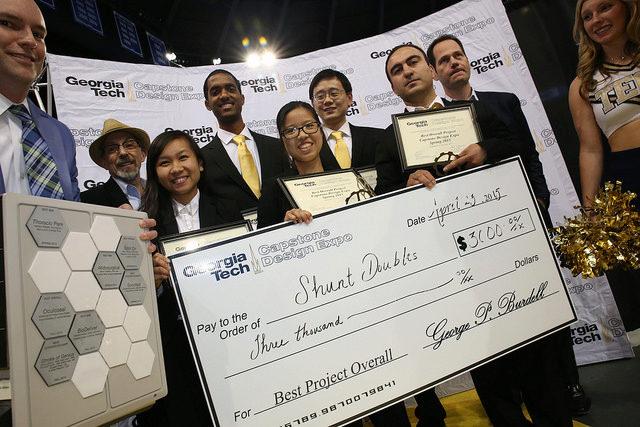Best Overall Project Award Goes to BME Team Shunt Doubles

I’m walking across the floor of McCamish Pavilion when I hear the proposition.
Excuse me, a young man says, but would I like to come learn about a machine that washes clothes in zero gravity?
I would. But there are literally hundreds of other projects vying for my attention at the moment: a robot that plays musical instruments, a shoe to protect Ethiopian children from disease, an alternative-motion baby swing.
This is the world of a judge at Georgia Tech’s Capstone Design Expo, a daunting but invigorating role. The expo, held each fall and spring, features work from senior design courses, in which undergraduates research problems, create prototypes, and offer solutions. Judges rate each project, and at night’s end, a team from almost every major present takes home a prize.
I work in the College of Engineering’s communication department, and I attended my first Capstone in 2013 to write an article about it. After agreeing to cover the event, I wondered if I was in for a long night: Was this essentially a science fair on steroids?
Well, no, unless the kids at your science fairs got assignments from companies like Coca-Cola, Home Depot, and Delta Air Lines. And quite a few of your classmates would have to have designed their own inventions, with some of them later turning those ideas into real-life startups and products. (Maybe your high school was like that, but mine wasn’t.)
This year, I was invited back to Capstone as a judge, assigned to meet with five teams from several majors. The spring 2015 event was the largest in Capstone history: Eleven schools were represented at the event, sponsored by Coca-Cola, with more than 1,000 students filling McCamish to share results and insights from their work.
I began the evening in a windowless (but snack-filled) room, where judges were briefed on the night ahead: We would each receive a list of teams to judge, and we’d grade each of our groups on criteria like presentation, creativity, and real-world applicability.
After grabbing a cookie, I headed downstairs to find my assigned teams. In my mind, I’d devised a strict plan of attack: Zero in on each group as quickly as possible, leaving plenty of time to wander the rest of McCamish and inspect some projects I’d heard about beforehand.
But, Capstone being Capstone, things went off-script. The teams I was due to visit were swamped by other judges, so I wound my way through the arena and strolled by random stations.
And I’m glad I did, because if I hadn’t, maybe I wouldn’t have spotted the biomedical engineering team Cuddle Care, which offered a way to keep newborns warm in the hospital. And what if I’d missed out on the mechanical engineering majors decked out in ‘80s workout gear? (They’d designed a device to give weightlifters personal feedback on their training.)
When I did manage to grade my assigned projects, I was impressed by teams’ tenacity and, on occasion, amused by the war stories they shared of cobbling their projects together.
Capstone Design Expo is a celebration of what makes Georgia Tech great: smart kids left and right, many of whom want to change the world with their ideas. And, with team names like the BeerTenders and Better Call Salmonella, it’s also a buffet of the strange and wonderful.
In some ways, judging the event is an exercise in futility. You’re swept up in the energy of it all, and by the end of the night, you’re stuffed with cookies and rooting for everyone to win.
Of course, only a few teams could take home prize money. After a long night of chatting up their projects, the hundreds of students converged in a corner of the pavilion, where they waited for winners to be announced and cheered whether their own names were read or not.
The overall winner, biomedical engineering team Shunt Doubles, developed a new way to assess shunt functionality. After the team’s win was announced, I asked some of them how they felt about their victory.
“I don’t think it’s sunk in yet,” team member Inez Raharjo told me.
She and the rest of her teammates looked overwhelmed but pleased, and a very small part of me understood how they felt.
- - - - - - -
WINNERS
The Capstone Design Expo has become the largest academic event on the campus calendar and sums up what Georgia Tech is all about: students using their knowledge to tackle real-world problems. The spring 2015 edition took place on April 23 in McCamish Pavilion and included 198 projects designed by 1,040 students. They came from 11 disciplines across three colleges: the College of Engineering, College of Architecture, and the Ivan Allen College of Liberal Arts. More than 75 sponsors funded projects, with Coca-Cola generously sponsoring the expo itself.
The graduating seniors competed for awards within their disciplines as well as for the best overall project award. -Ben Wright
Aerospace Engineering
Back-Country Emergency Air Responder (sponsored by Boeing)
Biomedical Engineering
Better Storage for BioMedical Samples
Electrical and Computer Engineering
Mechanical Engineering-Industrial Design
Mechanical Engineering
Five Guys (sponsored by Newell-Rubbermaid)
Materials Science and Engineering
GIW Reinforcers (sponsored by Georgia Iron Works)
Nuclear and Radiological Engineering
Team D2 (sponsored by Dr. Anna Erickson)
Public Policy
Farmaceuticals (sponsored by Centers for Disease Control and Prevention)
Industrial & Systems Engineering
HDSea (sponsored by The Home Depot)
ISYE21 Ebola Modelers (sponsored by Centers for Disease Control and Prevention)
ISYE16 Phillips 66 (sponsored by Phillips 66)
ISYE03 UPS (sponsored by UPS)
Interdisciplinary
Kids on the Move (sponsored by CSF)
Best Overall Project
Shunt Doubles (sponsored by Ian's Friends Foundation)
Shunt Doubles consisted of five biomedical engineering majors who designed a safe, easy, economical way for caregivers to monitor the effectiveness of shunts used to drain cerebrospinal fluid in the brain. The team intends to see if there is a market for their device.
Photo Gallery